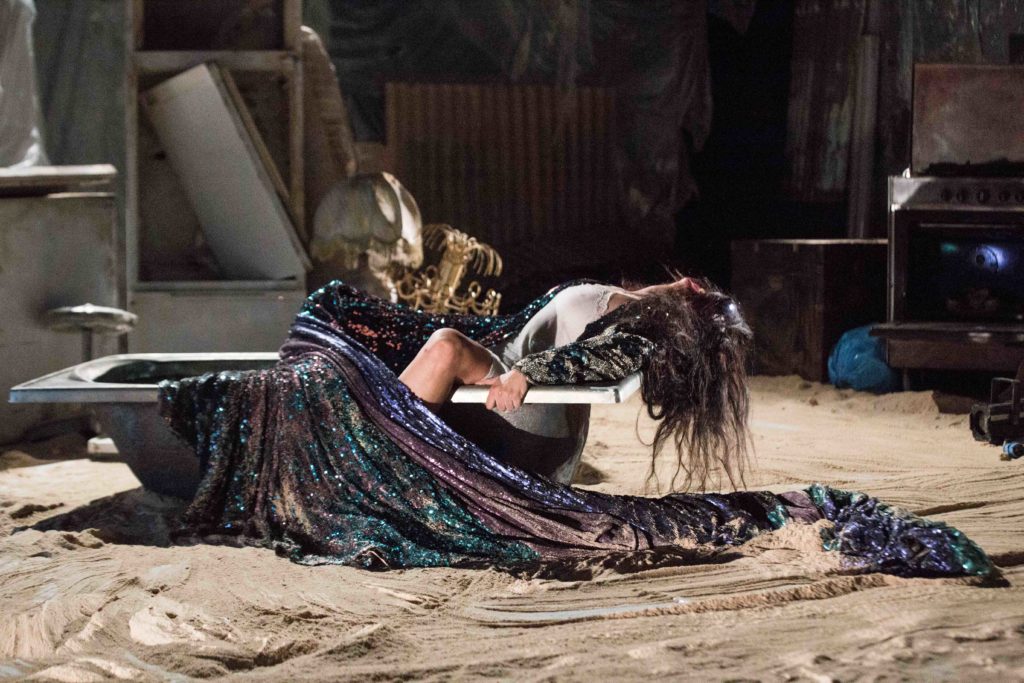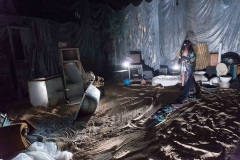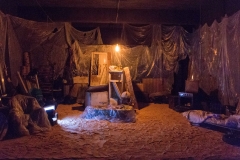
Written by Matteo Tarasco
With Teresa Timpano
and with Federica D’Angelo
Direction, scenes and lights Matteo Tarasco
Original music Claudio Bagnato
Costume designer Chiara Aversano
Stage director Paolo Pannaccio
Scenes and costumes assistant Antonino Serravite
Assistant director Pasquale Pacilè
Tailoring Sartoria “Non solo moda” di Fortuanta Marra
Scene foto Matteo Nardone
Co-production Accademia di Belle Arti di Reggio Calabria e Scena Nuda – Festival Miti Contemporanei
Direction Notes
Who is Circe? A goddess? A sorceress? A deceiver? A poisoner? Why does she live alone on a remote island in the middle of the sea? Why does she turn men into pigs? Many mysteries surround this disturbing figure. Our show is an investigation, a journey to discover a woman whose true story has not been told yet. Our Circe lives in a landfill, the dark cavern of a serial accumulator, an island of junk, an expanse of garbage bags and forgotten objects, a legacy of a ruined civilization, ours. Fumes of fires now extinguished rise tired towards the sky. The sky is always leaden. Distant thunder announcing a storm that is always lurking and never fails to unleash. An old song comes out of an abandoned radio. Always the same. In this no-man’s land we witness the end of a game that Circe has lost, like all of us.
Scenography Notes
The revision of the myth or the act of looking back and looking with new eyes, the attempt to penetrate an ancient text from a new perspective. We need to know the past, the great classics, but to reveal them differently than we have known them until now, the task of the theater today is not to pass down a tradition but to break its hold on us, re-vision, as recreation of a point of view, regeneration of the myth through the new perspective of an increased cultural and human social conscience, to better understand our role in the history of the world. Operating a re-vision of the myth also means recreating it by projecting new images onto its millenary figures. Once upon a time poetry was used to remind human beings of maintaining harmony with nature, with other living creatures. Today the poem reminds us that the human being has ignored this warning and has upset the world by creating chaos (this is why our scene represents a dump) attracting ruin on itself for future generations. Power, therefore, today does not consist in magic filters or miraculous potions, but in a new vision of the world of man’s nature. Circe can use this new power to communicate with nature to understand its sacredness, it is now to be celebrated as salvific. This to her today, we can ask, a renewed connection with nature, this we must implore the goddess of transformation we, contemporary human beings, shipwrecked in the sea of consumerism, we, to whom nature appears as a resource to be exploited, substance to be ingested, to be flooded with waste of our civilization. Let Circe transmute us, make us return to an original animal purity, let us rediscover love and respect for nature. Circe can be a powerful transformer today, taking on the task of directing the future of humanity towards new horizons, on a sea that is no longer a landfill but returned to its original function as a vital resource.
MATTEO TARASCO


